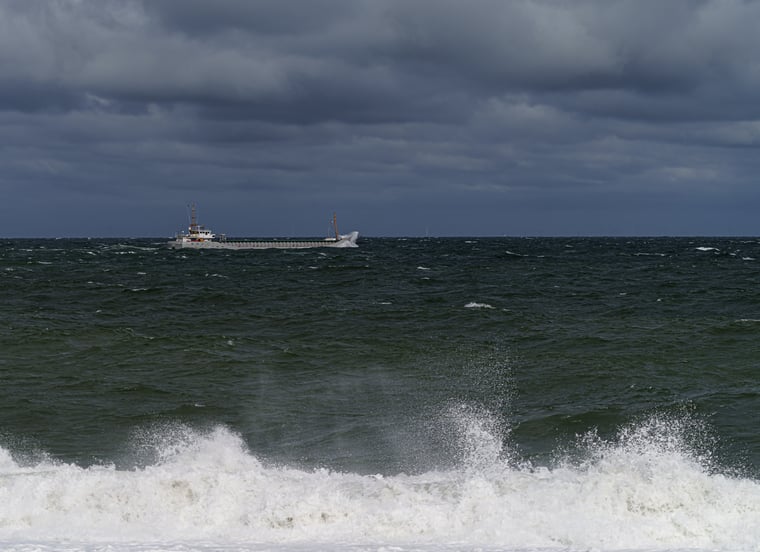Climate is changing rapidly. The atmosphere is warming due to the enhanced greenhouse effect. This results in less ice on the poles, increasing sea water levels and more extremes in both precipitation and droughts. The largest effect of temperature and precipitation extremes will occur over land. Furthermore, offshore operations are not that sensitive to those changes in climate. So, the question is: will the North Sea weather change due to climate change in such a way that it will affect your offshore operations?
Study set-up
To investigate whether climate change will affect offshore operations, we performed a literature study and combined that scientific data with our offshore weather forecasting experience to investigate if and how climate change will affect the weather over the North Sea. This study was mainly focused on the effect of climate change on wind speed, wind direction and significant wave height. Those elements are most widely researched and are often the most limiting weather factors during offshore operations.
Climate models and ERA-5 data
To research the effect of climate change on the North Sea weather climate models are required. Those models are designed to simulate general wind and wave patterns from the past and far into the future, to get an idea if and how current general wind and wave patterns might change in the future or has been changed in the past (Grabbemann & Weisse, 2008).
During this study we examined the ERA-5 data set, which is observational based, and is used as input to the climate simulation runs. This is a re-analysis data set packed with observations from 1958-2002. (Weisse & Gunther, 2007).
Figure 1 shows the 50- and 99-percentile of the significant wave height in the ERA-5 data set. The 50-percentile means that half of the waves are lower than the Hs value depicted, and half of Hs is higher than the values depicted over the period from 1958 to 2002. The 99-percentile means that 99% of the waves are lower than the Hs value depicted and 1% of the significant wave height is higher than the values depicted over the period from 1958-2002 (Weisse & Gunther, 2007).
.png?width=948&height=321&name=image%20(15).png) Figure 1: 50-percentile (left) and 99-percentile (right) of significant wave height (Hs) in the ERA-5 data set, from 1958-2002.
Figure 1: 50-percentile (left) and 99-percentile (right) of significant wave height (Hs) in the ERA-5 data set, from 1958-2002.
Important to note is that those ERA-5 re-analysis data sets underestimate the Hs by approximately 10%. This is valuable to mention, since those values are used as an input in the climate runs and therefore might affect the outcome of those simulations as well. The underestimation for extreme situations is even a bit higher (up to 20%).
Results and discussion
Different studies ran different climate models for the period (2079-2100). Figure 2 shows the results of two of those simulations. The Figure shows the increase of Hs against the 99-percentile ERA-5 data set for both simulation runs (Grabbemann & Weisse, 2008). It becomes immediately clear that there is an Hs increase during extreme situations for the period 2079-2100. Although there is a marginal difference in the exact Hs increase between the different simulations, both runs are very similar. Both runs hint to the same outcome, namely an increase of Hs during extreme conditions over the North Sea. The increase of Hs seems to be the highest over the middle and eastern half of the North Sea, close to the Norwegian coastline.
A possible explanation for this is that less sea ice over the North Pole, results in a longer fetch during northwesterly winds. As a result, waves have more time and space to grow higher. The effect of this is the highest over the eastern half of the North Sea. When traveling to the UK the increase becomes smaller and eventually becomes basically zero along the UK coast and the far S of the North Sea, close to the English Channel (Grabbemann & Weisse, 2008).
.png?width=450&height=640&name=image%20(16).png) Figure 2: Hs increase against the 99-percentile ERA-5 data set according to two different climate simulation runs.
Figure 2: Hs increase against the 99-percentile ERA-5 data set according to two different climate simulation runs.
During the same studies, the wind speed was also examined. The same ERA-5 data set was used to run 4 different scenarios to calculate the effect of wind speed during a new climate from 2079 to 2100. Figure 3 below shows the four different model simulations (Weisse & Gunther, 2007). The results between the different simulations are again very similar to each other. Therefore, the confidence of those different model runs is relatively high. All runs indicate an increase of wind speed of 0-1.5 m/s during extreme conditions over the southern half of the North Sea (Weisse & Gunther, 2007).
The highest wind speed increase occurs during westerly winds mainly just N of the Netherlands, in between the UK and Denmark.
.png?width=940&height=739&name=image%20(17).png) Figure 3: Wind speed difference between ERA-5 99-percentile data set and climate predictions for 2079-2100 according to four different simulations.
Figure 3: Wind speed difference between ERA-5 99-percentile data set and climate predictions for 2079-2100 according to four different simulations.
Besides the effect that extremes will become more extreme, there is also a trend visible that extreme wind and wave events will occur more frequently (Bonaduce at al., 2019). Figure 4 shows that extremes will becomes more extreme (left) and that at the same time the number of extreme events is increasing over the years for a location within the German Bight. Important to note is that the year-to-year variation is very large. Nonetheless, the researchers were able to fit trend lines (red, green, and yellow lines) which were assessed and found to be significant to describe to global trend (Weisse & Gunther, 2007), (Boukhanovsky, 2007).
.png?width=910&height=428&name=image%20(18).png) Figure 4: Extreme Hs over the German Bight over the past years (left) and number of sever events over the recent years (right).
Figure 4: Extreme Hs over the German Bight over the past years (left) and number of sever events over the recent years (right).
Besides the wind and waves increases, the North Sea is warming rapidly. It warms twice as fast as the large oceans and its annual average temperature has gone up with 3 degrees during the last 45 years. The annual North Sea temperature is expected to rise with 1.7-3.2 degrees Celsius more until 2100. Warmer sea waters mean more extreme weather.
Showers and thunderstorms will become more active due to those warmer waters, but at the same time the chance of fog will be higher as well. Thunderstorms and fog for instance are of a too small scale to capture for the climate runs presented above. Combined with the earlier mentioned underestimation of the ERA-5 data set and the missing of local sever weather within the models, it is very likely that the increase in both Hs and wind speed is still an underestimation of what we can expect in 2079-2100.
Conclusion
From this research it became clear that both wind speed and Hs will increase in a future climate. The highest increase will be during severe weather events. Furthermore, the number of severe weather events will increase as well. This is well supported by all discussed climate simulations. Important to note is that those climate simulations might still be an underestimation of what we can really expected in the period from 2079-2100, since the ERA-5 data underestimates wind and waves in general by approximately 10-20%.
This will lead to less workable offshore conditions and more weather-related down time. Most down time will be N of the Netherlands and close to Denmark and Norway, since the increase in Hs will be the highest over there. The least down time increase will occur over the far S of the North Sea and along the UK coast, due to their sheltered position.
References
Bonaduce at al. (2019) ‘Wave climate change in the North Sea and Baltic Sea.’ Journal of Marine Science and Engineering.
Boukhanovsky at al. (2007) ‘Spectral wave climate North Sea.’ Applied Ocean Research 29 (2007) 146-154.
Weisse, R., Gunther, H. (2007). ‘Wave climate and long-term changes for the southern North Sea obtained from a high-resolution hindcast 1958-2002.’ Ocean Dynamics (2007) 57: 161-172.
Worth, K., Weisse, R., Storch von, H. (2006). ‘Climate change and North Sea storm surge extremes: an ensemble study of storm surge extremes expected in a changed climate projected by four different regional climate models.’ Ocean Dynamics (2006) 56: 3-15.
Grabemann, I., Weisse, R. (2008). ‘Climate change impact on extreme wave conditions in the North Sea: An ensemble study.’ Ocean Dynamics (2008) Springer, Final Draft.




